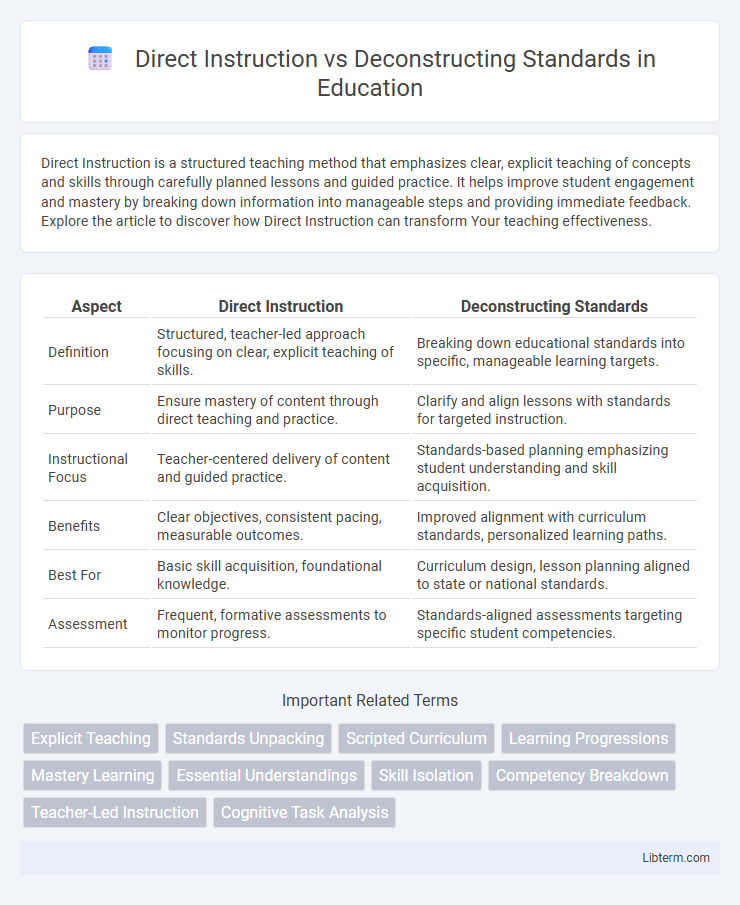Direct Instruction is a structured teaching method that emphasizes clear, explicit teaching of concepts and skills through carefully planned lessons and guided practice. It helps improve student engagement and mastery by breaking down information into manageable steps and providing immediate feedback. Explore the article to discover how Direct Instruction can transform Your teaching effectiveness.
Table of Comparison
| Aspect | Direct Instruction | Deconstructing Standards |
|---|---|---|
| Definition | Structured, teacher-led approach focusing on clear, explicit teaching of skills. | Breaking down educational standards into specific, manageable learning targets. |
| Purpose | Ensure mastery of content through direct teaching and practice. | Clarify and align lessons with standards for targeted instruction. |
| Instructional Focus | Teacher-centered delivery of content and guided practice. | Standards-based planning emphasizing student understanding and skill acquisition. |
| Benefits | Clear objectives, consistent pacing, measurable outcomes. | Improved alignment with curriculum standards, personalized learning paths. |
| Best For | Basic skill acquisition, foundational knowledge. | Curriculum design, lesson planning aligned to state or national standards. |
| Assessment | Frequent, formative assessments to monitor progress. | Standards-aligned assessments targeting specific student competencies. |
Understanding Direct Instruction: Core Principles
Direct Instruction emphasizes explicit teaching through clear, scripted lessons designed to maximize student engagement and mastery of skills. Core principles include structured, sequential content delivery, frequent assessment, and immediate feedback to ensure comprehension and retention. This method contrasts with deconstructing standards by focusing on consistent, teacher-led instruction rather than student-driven exploration of learning objectives.
Deconstructing Standards: An Overview
Deconstructing Standards involves breaking down educational standards into specific, manageable learning objectives to clarify expectations and ensure alignment with curriculum and assessments. This method emphasizes deep understanding by identifying key skills and knowledge embedded in standards, allowing for targeted instruction and assessment design. It supports teachers in planning lessons that precisely address required competencies, enhancing student mastery through focused, standards-driven learning.
Historical Development of Teaching Approaches
Direct Instruction emerged in the 1960s as a structured, teacher-centered approach emphasizing scripted lessons and clear, measurable objectives. Deconstructing Standards developed later as educators sought to break down complex educational standards into manageable learning targets that promote critical thinking and student autonomy. The historical shift reflects a move from rigid, uniform instruction toward more flexible, standards-based frameworks designed to accommodate diverse learning needs.
Key Differences Between Direct Instruction and Deconstructing Standards
Direct Instruction emphasizes explicit teaching through clear, structured lessons focused on specific skills and objectives, ensuring mastery through repetition and guided practice. Deconstructing Standards involves breaking down educational standards into smaller, manageable components to understand the exact learning targets and assessment criteria, facilitating targeted lesson planning. Key differences include Direct Instruction's focus on teacher-led delivery versus Deconstructing Standards' analytical approach to unpacking curriculum goals for alignment and clarity.
Impact on Student Learning Outcomes
Direct Instruction consistently improves student learning outcomes by providing clear, structured, and explicit teaching methods that enhance comprehension and retention. Deconstructing Standards enables educators to break down complex learning goals into manageable objectives, fostering targeted instruction that aligns with assessment criteria and supports skill mastery. Both approaches increase student achievement, but Direct Instruction offers more immediate improvements in foundational skills, while Deconstructing Standards promotes long-term conceptual understanding and critical thinking.
Teacher Roles and Responsibilities
Direct Instruction requires teachers to actively deliver structured lessons with clear objectives, ensuring consistent pacing and immediate feedback to guide student learning. In Deconstructing Standards, teachers analyze and break down academic standards into specific, manageable learning targets to design tailored instruction that meets diverse student needs. Both approaches demand teachers to assess student progress continuously, but Deconstructing Standards emphasizes curriculum alignment and targeted skill development, while Direct Instruction focuses on explicit teaching and mastery of content.
Curriculum Design and Implementation
Direct Instruction emphasizes structured, teacher-led lessons with clear, scripted guidance to ensure consistent skill acquisition and measurable outcomes in curriculum design. Deconstructing Standards involves breaking down complex educational standards into smaller, manageable learning targets to promote alignment between instructional goals and assessment criteria. Effective implementation requires blending Direct Instruction's explicit teaching methods with the granular focus of Deconstructed Standards for targeted student mastery and curriculum coherence.
Assessment Strategies in Both Models
Direct Instruction employs frequent formative assessments with scripted feedback to ensure mastery of specific skills, emphasizing clear objectives and measurable outcomes. Deconstructing Standards uses performance-based assessments that require students to demonstrate understanding through applied tasks aligned with complex learning goals. Both models integrate continuous assessment cycles, but Direct Instruction prioritizes incremental skill checks while Deconstructing Standards focuses on evaluating conceptual depth and real-world application.
Challenges and Limitations of Each Approach
Direct Instruction often faces challenges such as limited adaptability to diverse learning styles and potential overemphasis on rote memorization, which can hinder deeper conceptual understanding. Deconstructing Standards may encounter difficulties in consistency and coherence since breaking down complex standards can lead to fragmented instruction and confusion among educators. Both approaches require careful balancing to ensure comprehensive, engaging, and effective learning aligned with curriculum goals.
Choosing the Best Approach for Diverse Classrooms
Direct Instruction offers structured, teacher-led lessons that ensure clear, consistent skill mastery, benefiting learners needing explicit guidance and routine. Deconstructing Standards breaks complex curriculum goals into manageable objectives, promoting critical thinking and personalized learning paths that support diverse student needs. Selecting the best approach depends on classroom diversity, with Direct Instruction providing reliability for foundational skills and Deconstructing Standards fostering adaptability for varied learning styles and abilities.
Direct Instruction Infographic

 libterm.com
libterm.com